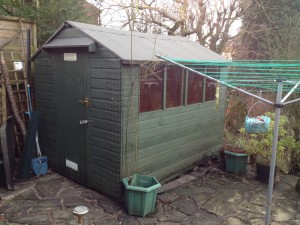I have moved back to Burnley! Soon I should be able to start making progress on building my first instrument. Currently my tools and materials are piled up in crates and boxes in my bedroom and garage, and my milling machine is broken down into several pieces, so my first task is to convert this damp 6×8 feet garden shed into a cosy little workshop:
At some point I hope to save up enough money to replace it with something a bit bigger and more substantial that is designed from the ground up to be dry, insulated and secure. For now, my plan is to install a tiny coal stove (which can later be transferred to the new workshop), repaint the outside walls, add more ventilation, and store as little as possible in there when I’m not actively using it.
The first thing I intend to make in the new shop is a workbench. Nothing massive or fancy, just a solid pine worktop (made from a spare kitchen table I found in my parents’ loft) at a convenient height, secured to the floor/wall, with some old cast iron vices and a planing stop. After years of working on flimsy trestle tables and Black and Decker Workmates, it will be great to have a sturdy fixed bench that doesn’t skitter across the floor when I try to plane something. In a stroke of good luck, just as I was starting to think about workbench design, I happened to stumble across a copy of The Workbench Book by Scott Landis for a couple of pounds in a local charity shop. It’s a hefty book filled with inspiring ideas. My first self-built workbench probably won’t be my last, but seeing what other woodworkers are working on has helped me to identify more clearly what features I think I will find most useful for the type of work I do and avoid some things I might have regretted later (e.g. I don’t want any dog holes in the top: too easy to drop small parts down them).
Making concertinas from scratch requires a lot of tools. Metalworking, woodworking, leatherwork, and some very specialised things like a tuning rig. In addition, there are opportunities to speed up production if you invest in special tooling and machines. In order to try to avoid falling into the trap of Tool Acquisition Syndrome (gotta collect them all!), I’ve started categorising tools like this before I decide whether I need to buy one or not:
- Tool that is the bare-minimum cheapest way to perform an essential operation. For example, it’s perfectly possible to cut out fretwork ends using a cheap and cheerful bent steel fretsaw you can pick up for a quid or two at most car boot sales. I have a few of these in various sizes. They are a bit slow and tiring to use for long periods, but they are perfectly capable of producing excellent results.
- Tool that speeds up an essential operation. For example, a scroll saw is a machine that does essentially the same job as a fretsaw but can cut perhaps four times as fast with less physical effort. The difference is actually probably less significant with more complex designs because you spend so much of your time stopping and moving the blade to a new piercing. I have both a treadle and an electric scroll saw. I should probably get rid of one of them to save space, but I need to do some proper side-by-side tests before deciding which of them I prefer to use.
- Tool that is a higher quality version of something I already have. For example, my scroll saws are both hobby-grade machines: either will do the job for now, but certain features are inaccurate, fiddly and annoying to use, or not built to last. If in the future I find myself with the budget to upgrade, it would be nice to step up to a higher quality saw like a Hegner, or maybe even a vintage industrial machine.
- Tool that would be nice to have, but isn’t essential to concertina-making at all. I’m struggling a bit to continue with the fretwork analogy here. Let’s say an electric bandsaw: one could perhaps argue that it could be used to rough out the blank more quickly than with a handsaw, but it isn’t of any use for cutting the fretwork itself because you can’t get the blade inside a closed piercing (and they can’t cut very fine details and tight curves).

Hi Alex,
I used garage floor paint on my workbench top and have a small lip around the edge to stop small parts rolling off.
For damp proofing some insulation is a good idea as it slows the change in humidity which can reduce condensation on big metal objects. Some people also recommend heating but I can’t afford that in my shed. I horde those crystal sachets you get with electronics and beef jerky, and put them in with the lathe tools and drill bits.
You can have too many tools but you can never have too much storage. I’ve added extra drawers, cupboards and shelves as I’ve gone along but also a periodic purge of “excess” can help.
Good luck with the refit.
Cheers,
Andy
Thanks Andy! Currently the plan is to store the hand tools in drawers in the house, and only take out whatever I need for the current job. The machines will just have to survive with regular coats of oil on the steel parts. It is actually staying reasonably dry in there as long as I light the coal stove every day.